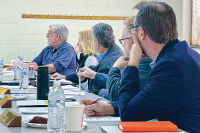A stirring story of America’s push west

Sometimes we open a book, slip into its pages, and find ourselves the recipients of three wonderful gifts: information and enlightenment, lively prose, and a great story.
The Pioneers: The Heroic Story of the Settlers Who Brought the American Ideal West (Simon & Schuster, 2019, 330 pages) grants all three gifts to its readers.
Here Pulitzer Prize winner and popular historian David McCullough whisks us out of the 21st century and drops us into the Northwest Territory in the years after the American Revolution. Most Americans have only a cursory knowledge of this place and its importance in our history — I include myself in that number — and The Pioneers acts as a time machine taking us into the lives of those whose struggles, sacrifices, and wisdom left a mark on our country that prevails to this day.
We begin our trek to the “Ohio country,” a wilderness that would eventually become the states of Ohio, Indiana, Illinois, Michigan, and Wisconsin, in 1786 in Boston’s Bunch of Grapes tavern. Here the Reverend Manasseh Cutler and others gathered to “launch a highly ambitious plan involving the immense reach of unsettled wilderness knows as the Northwest Territory.” After a good deal of political dickering, influenced in large part by the “ingenious, systematic and successful piece of lobbying” by the Reverend Cutler, the fledgling Congress of the United States issued the Northwest Ordinance of 1787, opening the new territory to settlement. As McCullough then writes, “the great Northwest Ordinance of 1787 stands alongside the Magna Carta and the Declaration of Independence as a bold assertion of the rights of the individual.”
This Ordinance put its stamp on the American soul. It stressed the importance of freedom of religion and of individual morality. It stated that “schools and the means of education shall forever be encouraged.” It included a tenet with dramatic ramifications: “There shall never be slavery nor involuntary servitude in the said territory.” As McCullough points out, “It was almost unimaginable that throughout a new territory as large as all of the thirteen states, there was to be no slavery.”
McCullough then introduces us to the pioneers, so many of them from New England, who made these provisions a reality. From farmers who scrabbled for a living to aristocrats like Harman Blennerhasset and his wife Margaret, from physicians and scientists like Dr. Samuel Hildreth to the keelboat men who plied the Ohio River, we meet the people who planted their dreams in this region along with their gardens and their corn fields. They built the schools as directed by the Northwest Ordinance and kept slavery out of this territory, all the while facing epidemics, inclement weather, crop failures, and battles with native Americans and with ambitious men like Aaron Burr.
Related Items
Throughout most of the book, McCullough focuses on the settlement of Marietta in Ohio, one of the earliest settlements in the region. It was to this town that so many New Englanders first made their way to the Northwest Territory.
What impresses us about these New England transplants to Marietta was the learning so many of these men and women brought to this raw wilderness. Some of the men were graduates of Yale and Harvard, and many of the settlers, men and women, were avid readers. In the letters and diaries cited by McCullough, these men and women repeatedly refuse to complain of their suffering, expressing instead their hopes and dreams for the new territory.
At the end of The Pioneers, McCullough awards this epitaph to Marietta and the pioneers who passed through that settlement:
“… the pioneers of Marietta had finished their work, each in his or her way, and no matter the adversaries to be faced, propelled as they were by high, worthy purpose. They accomplished what they had set to do not for money, not for possessions or fame, but to advance the quality and opportunities of life — to propel as best they could the American ideals.”
So they did. And they deserve both our remembrance and gratitude.
•••
Years ago, the novels of Jon Hassler entered my life. Mostly set in Minnesota, a state I’ve never had the pleasure to visit, Hassler connected with me along with many other readers through his fictions set in small towns and universities. Staggerford, North of Hope, A Green Journey, Rookery Blues, The Dean’s List: these were just some of the novels that captivated me.
In Jon Hassler —Voice of the Heartland: A Critical Appraisal of His Work (Nodin Press, 2019, 308 pages), Edwin Block, who for years corresponded with Jon Hassler and has published numerous articles on his work, has given us both a brief biography of the writer and a critique of all his major works.
In Esquire Magazine, Ernest Hemingway once said of books and writing:
“All good books are alike in that they are truer than if they really happened and after you are finished reading one you will feel that it all happened to you and afterwards it all belongs to you: the good and the bad, the ecstasy, the remorse and the sorrow, the people and the places and how the weather was. If you can get so that you can give that to people, then you are a writer.”
Jon Hassler was a writer.
Thank you, Ed Block and Nodin Press, for reminding us of that.
(Jeff Minick is a writer and teacher. This email address is being protected from spambots. You need JavaScript enabled to view it.)









